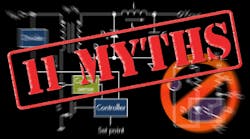This file type includes high-resolution graphics and schematics when applicable.
Roger Gabriel, Senior VP Global Technical Sales, Semitrex
It seems many digital engineers take power for granted, but power supplies are being scrutinized as supply voltages keep decreasing. Supply tolerances are tightening as engineers work to decrease power, increase yield, and minimize supply-induced noise. Power-supply designs must address ripple, noise, spikes, compression, load response—both dynamic and static—as well as supply-induced signal noise and jitter. Any noise or transients on power rails propagate throughout the system.
2. Power doesn’t matter.
Many nuances in a power-distribution network can cause serious problems even in a purely digital design. Issues may include SoCs not coming up properly due to clock and data jitter, or a supply voltage droop that decreases propagation delay through a digital device, potentially resulting in failures.
In some applications, such as data centers, power demands and inefficiencies resulting in heat are key limiting factors on density and require expensive cooling and connectivity. Clean power becomes ever-more important with increasing speed and density. Reducing signal amplitudes for faster switching requires reduced noise margins in power supplies.
3. Power is low tech.
In fact, power is a dynamic field with technology changes such as gallium nitride (GaN) offering smaller size, higher power, less heat loss, and efficiency improvements. There are also innovations from power-supply system-in-package (PSSiP) manufacturers that improve performance in supplies powering everything from IoT endpoints to mobiles, TVs, servers, and everything between that needs ac converted to low dc voltages.
4. Converting ac mains to low-voltage dc requires a buck regulator and transformer.
Certain techniques use innovative capacitive-based technology that eliminates the need for a buck regulator or a transformer in certain applications, depending on voltage and current requirements. And when a transformer is used, the preliminary capacitive stages allow for a smaller transformer, with lower-cost coil and windings.
5. Switched-capacitor-based conversion techniques are not cost-effective and cannot carry significant power.
Efficiently engineered capacitor-based, voltage-reduction stages allow such solutions to be cost-effective. Aligning stages in series rather than in parallel allows each stage's capacitors to be optimally sized to decreasing voltages proceeding through subsequent stages. In fact, it’s possible to supply power in the tens of watts with purely capacitive stages—no buck required.
6. A transformer is required for isolation.
A thoughtfully designed capacitor-based design can provide capacitive isolation, giving the required 4-kV isolation between the high-voltage mains and low-voltage dc. Care must be taken to ensure that this isolation is under hardware control, so that even in the case of a software failure, there’s never a DC path from input to output.
7. Switched-mode power supplies (SMPS) require many components from a number of vendors.
It does seem to be the case that many power-supply component vendors seem averse to increasing the level of integration—perhaps in order to avoid cannibalizing their existing component business. This opens up opportunities for a supplier to integrate most components onto a mixed-mode IC and place it with some discrete components on a PSSiP. Doing so can replace a 110-V ac to 3.3-V dc supply with 68 parts using a small 6-pin PSSiP.
8. Primary-side regulation (PSR) is less accurate than secondary side.
The PSR technique uses switching rates along with FET and capacitor selections to allow for an accurate reading of output voltage that provides 1% regulation accuracy—without the tertiary winding required by existing PSR techniques (see figure). This while eliminating the nine extra parts required by an opto-isolated secondary regulation scheme.
Primary-side regulation does not need a tertiary winding, nor does it need the nine extra parts required by an opto-isolated secondary regulation scheme. Thereâs optional 5% (analog) or 1% (digital) deviation regulation.
9. Switchers are noisy and present EMI challenges.
It’s true that by virtue of their inherent design characteristics, switching power supplies generate electromagnetic interference (EMI) composed of signals of multiple frequencies. It’s due to the fact that internal ac voltages are not pure sine waves, but square waves made up of the superposition of many higher frequencies per Fourier analysis. However, a number of techniques exist for minimizing noise generation, and for mitigating conducted and radiated EMI. Some techniques utilize much lower switching frequencies, which greatly alleviate EMI, crosstalk, and noise concerns.
10. Power-supply efficiencies are tuned for a small power range and decrease significantly at low power.
It’s true that buck-regulator efficiencies roll off steeply below about 50% of the full power they’re designed to carry. One way around this problem is to use a buck regulator when power demand is high, and automatically change to a capacitor-only mode when the buck's efficiency tails off. This technique is used in Semitrex's TRONIUM module that provides efficiencies in the mid-90% range across widely varying power demand requirements.
11. The U.S. Department of Energy's Level VI and the ECC's 30-mA (and decreasing) vampire power requirements present a technical challenge.
In fact, some 50 companies have filed for an extension to the DoE’s February 10 compliance date, indicating that they are having challenges meeting this requirement. But the technology exists! Many supplies already comply with the DoE 100-mW requirement or beat Level VI's vampire power by 200X—switching automatically into standby mode where it consumes just ½ mW with 110-V mains and 1 mW with 220-V mains.
While SMPS design has come a long way from its early days, challenges continue as voltages decrease and speeds increase. Thus, it often makes sense for system-design engineers to purchase power-supply systems in packages that address power-supply design concerns, allowing them to focus on their company’s application.




